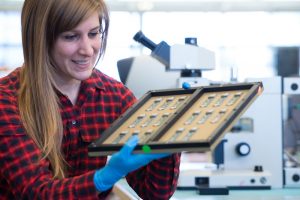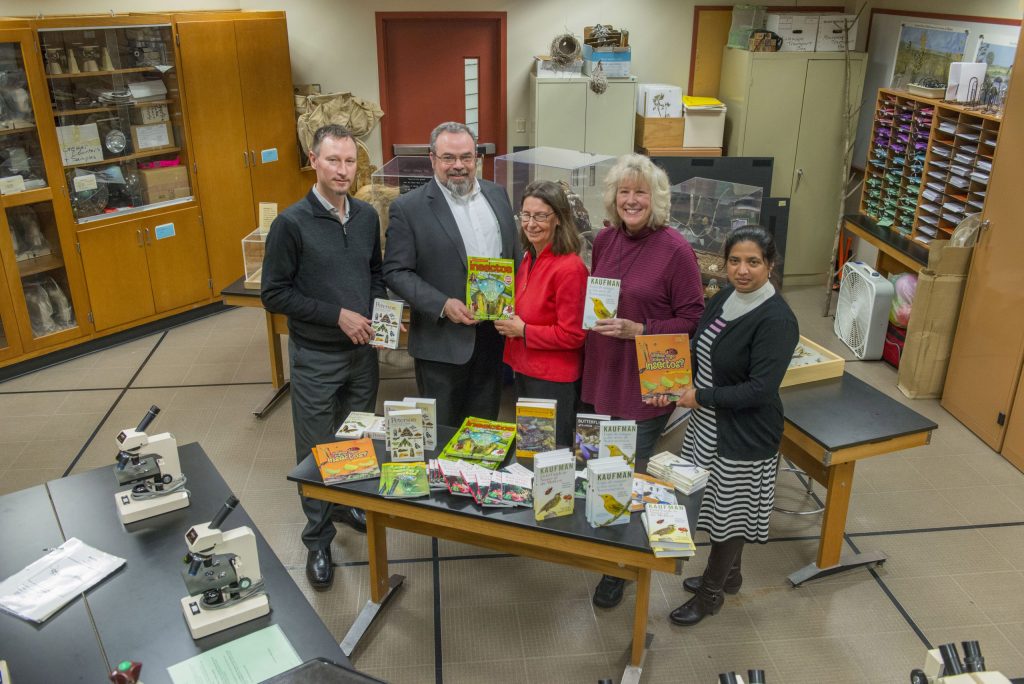
Stephanie Timpone works on electronics for the CMS experiment at Fermilab’s SiDet facility. Photo: Reidar Hahn
How long have you worked at Fermilab?
I’ve worked at Fermilab for three-and-a-half years now. Before coming here, I was a high school physics teacher for three years, but I was looking to break into engineering.
What led you to Fermilab?
Coming from a physics background, the engineering physicist position, which is what I do now, was a perfect mix of engineering and physics for me. It was a good way of getting my foot in the door and gaining engineering skills. Plus, I always knew about Fermilab from studying physics in college so it was such an exciting prospect to work here.
What does a typical day in the life of an engineering physicist look like at Fermilab?
I don’t know if there is a typical day! Other engineering physicists I know all do different things. I work in the Particle Physics Division Mechanical Engineering Department and at SiDet [Silicon Detector Facility], and I do a lot of design work like designing tooling for building detector assemblies. I also coordinate the assembly and integration of the detectors, so there is a lot of hands-on work, which I love.
What’s your favorite thing about working here?
It’s a tie between the uniqueness of the work is and how smart and passionate my colleagues are. Working with people from all over the world and being exposed to that is also a really fun part of the job.
What teaching skills have you transferred to your work at Fermilab?
Presentation and interpersonal skills that I gained from teaching have definitely helped me in my work and communicating with different audiences. I interface daily with scientists, engineers, technicians, vendors and students, and teaching has made it easier to effectively communicate my ideas, questions and solutions.
Is there anything else you’re involved in at Fermilab?
I have done a lot of outreach this year, like giving tours at SiDet. I did some outreach working with a STEM initiative for Girl Scouts in the area, and I was involved in a lot of the planning for the tours of SiDet for Fermilab’s 50th anniversary. Having the teaching background has sort of facilitated that kind of outreach. I also had the opportunity to give presentations about my work with CMS at an evening event at the Adler Planetarium recently.
What’s one thing about you that might surprise people?
I did an Ironman triathlon a few years ago. It was the hardest 12-and-a-half hours of my life. I started doing short triathlons and got really into the sport, so went on to longer and longer ones and then eventually just told myself to commit to an Ironman – and I did it!
What do you do outside of work?
I like to stay active, and I’ve recently been thinking about races I can do next summer. I live in downtown Chicago and I like to take advantage of what the city offers, so going to museums and concerts and street festivals – that kind of thing. I am also working on finishing my master’s in materials science at Illinois Institute of Technology. This is something the lab has been very supportive of since I started working here.
‘Tis the season for giving, and Fermilab Natural Areas, a nonprofit group that helps restore the U.S. Department of Energy’s Fermi National Accelerator Laboratory natural areas, is in the spirit.
On Thursday, Dec. 21, Fermilab Natural Areas donated a selection of environmental education books and materials to Fermilab’s Lederman Science Center.
The materials were purchased with a grant from the Nature Conservancy’s Volunteer Stewardship Network. The donation includes field guides for Fermilab docents to use during tours, and Spanish-language nature books for visiting students.
In attendance at the donation ceremony, which took place on Thursday at Lederman Science Center, were Fermilab Natural Areas President Penny Kasper, FNA Vice President Liz Copeland, Fermilab Chief Operating Officer Tim Meyer, Fermilab Office of Education and Public Outreach Manager Spencer Pasero and Fermilab Chief of Staff Hema Ramamoorthi.
“Every year, the Lederman Science Center hosts thousands of students who visit Fermilab to experience and learn in the ecosystems found on site,” said Spencer Pasero, head of the Fermilab Office of Education and Public Outreach, which manages the center. “We are very grateful to Fermilab Natural Areas for donating these materials, which will enrich that experience for these students and their teachers.”
The Lederman Science Center welcomes more than 4,000 visitors each year and more than 3,000 students for ecology-themed field trips, and is the site for the annual Fermilab Outdoor Fair, during which dozens of local students learn about the Fermilab ecosystems. Among the materials slated for donation are numerous field guides to birds, butterflies, moths and beetles of North America. Many of the materials are in Spanish.
“The Education Office is grateful to Fermilab Natural Areas for donating these much needed resources,” said Maureen Hix, staff member at the Lederman Science Center. “These wonderful guidebooks will facilitate our life science field trips and give support to our docent staff and also provide the opportunity to engage Spanish speaking students in our outdoor educational activities.”

In the spirit of the season, the not-for-profit organization Fermilab Natural Areas presented the Lederman Science Center at Fermilab with an early gift. FNA, represented by President Penny Kasper (center) and Vice President Liz Copeland (second from right), donated a selection of environmental education books and field guides in English and Spanish to the center. The donation was made possible with a grant from the Nature Conservancy’s Volunteer Stewardship Network. Fermilab Chief Operating Officer Tim Meyer (left), Fermilab Office of Education and Public Outreach Manager Spencer Pasero and Fermilab Chief of Staff Hema Ramamoorthi received the gift on behalf of Fermilab. Photo: Fermilab
